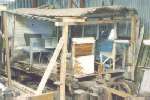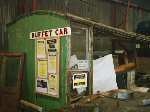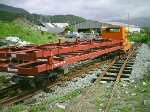Ashbury ‘Corridor’ Carriages No.s 9 & 23
This pair of carriages currently run on the Welsh Highland Heritage Railway as NWNGR No. 9 (later numbered 25) and ‘Buffet Car’ WHR No. 23 (which had earlier been NWNGR No. 10). In this form, they represent two distinct periods of their combined histories, namely the NWNGR and WHR.
The Corridor Coaches
The two carriages were built by the Ashbury Railway Carriage & Iron Co. in 1893 at their Openshaw works near Manchester (although Openshaw is about 2 miles from the city centre, it only officially became part of Manchester in 1890) and were delivered as a pair. They were ordered for the North Wales Narrow Gauge Railway (NWNGR) which later became the Welsh Highland Railway. They were identical in every way except for the ‘grab handles’ which are mounted next to each door to aid access from platform level up into the carriage; we do not know why they differed in this detail alone as they were ordered as an identical pair. It is possible that No.9’s ‘grab handles’ went missing in transit when all exterior fittings were (most likely) removed to avoid damage or theft. The Railway Company would then have probably sourced replacements locally, rather than wait for new ones to be sent from Manchester. This would then explain why they were made of iron as opposed to the brass handles of No.10.
The carriages were widely regarded as the nicest looking on the railway, due to their neat proportions and tidy finishing. They had wooden bodies of oak and teak construction with oak beams forming the chassis that the bogies, couplings, and brake gear were supported from. They now have steel underframes so that they conform to modern safety standards.
Seating
The seating was all Third Class, each carriage having seating for up to 38 passengers. Access was provided by means of a door at each corner, inset from the ends, allowing room for wooden ‘bench’ seats across the full width of the carriage at each end, providing seating for up to four passengers each. The remaining seats were a similar wooden ‘bench’ style, also running across the width of the carriage. However, they were configured in a back-to-back fashion so that each row had seats facing each other with part of the next row and the previous row stemming from those seats supported by a symmetrical woodwork pattern forming the supports for the seats in both directions. Also, the seats did not run across the entire width of the carriage and instead had a two person on one side with a single seat on the other. This arrangement formed an aisle along the length of the carriage, off-set to one side, allowing a person to enter a door at one end, walk all the way through, and exit a door at the opposite end whilst also gaining access to the seating in the middle. This is why they came to be referred to as the ‘corridor’ carriages even though there were no corridor connections or side corridors - such as are commonly seen on standard gauge railways. An aisle is not exactly a corridor but it serves a similar purpose here.
Windows
Each door was fitted with a ‘drop-light’ - windows operable by means of a leather strap and a simple mechanism. However, the remaining 10 windows could not be opened and, instead, ventilation was provided by louvres running the entire length of the carriage along each side, just above the windows. Our replica of No.9 does have ‘drop-lights’ in some of the middle windows which we added so the carriage could be more quickly and easily aired out. These are also present in the Buffet Car because it was modified later in its life, as will be explained below. They also have an unusual feature in that the top few inches of the seat backs, which rise above the window sills, are not lined up with the window frames. This looks quite odd from the outside, as if the seats are in the wrong place; however, they are still symmetrical. The middle seat back does line up with the window frame at the centre of the carriage, the seats are equally spaced, as are the windows, but there are more windows than there are rows of seats.
Other Features
They were the first of the railway’s carriages to be painted in the Company’s latest livery of solid maroon and they were finished off with the Company’s initials (NWNGR), 3rd class numerals, and their running numbers all in yellow and shaded with red. They also had wooden plaques at the centre of each side displaying the company crest. They were delivered fully fitted with the same ‘single pipe’ Westinghouse air braking system the railway was already using on the existing carriages and locomotives. They each had three paraffin burner lamps for lighting which were set into, and along the apex of, the roof. One was dead centre and the other two were set half way between the centre and each of the ends, respectively. When the lamps were removed, the remaining holes could be plugged with ‘bungs’ that were chained to the roof. Each ‘bung’ also had its own holder on the roof where it could be stowed securely; many photos, however, show these ‘bungs’ loose but still on their chains; even when the lamps were not there. This was the most common way to light railway carriages at the time but on the NWNGR’s bumpy track; they probably just kept falling out.
Alterations
Sometime between 1900 and 1910, No.10; which would later become the Buffet Car; had a partition added half way along, dividing the carriage into two separate sections of equal size. One side became First Class whilst the other remained Third Class. We know this had happened by 1910 because photographs taken at that time show No.10 to be missing an oil lamp housing in the middle that would have needed removing so as not to foul the partitioning wall. Some sources, including the well renowned author of several books chronicling the history of narrow gauge railways in North Wales; James I. C. Boyd, assert that the First Class section was small, but the photographic evidence is clear, so this assertion was most certainly an error. The newly created First Class section was fitted with perimeter seating re-using some of the existing wooden seats for each end of the new compartment, albeit now upholstered and cushioned, and two new sprung and cushioned bench seats set lengthwise along each side. These seats survive in the restored carriage today, although we have had to re-upholster them. The two sprung seats that still survive today are a style commonly seen in trams and buses of the era. They were possibly originally made for a tram rather than specifically carriage.
By 1922, the NWNGR had become the Welsh Highland Railway (WHR) and the line had been extended through to Porthmadog with a connecting line to the Ffestiniog Railway (FR), the two railways even shared a new station ‘Porthmadog New’. Trains from either line could now run on both the WHR and the FR. However, the WHR (formerly NWNGR) carriages were too tall to fit through the Moelwyn tunnel and some of the bridges along the FR’s mainline. In order to allow through running, the entire stock was cut down in height and converted to the vacuum breaking system used by the FR. As both railways were under common management at the time (even though they remained separate companies) the work was carried out fairly quickly, but one carriage at a time, at the FR’s own works: Boston Lodge.
The results of the ‘cutting down’ were, at best, a mixed bag. Our current flagship locomotive Russell famously still didn’t fit the loading gauge afterwards; realising only too late that its width was a problem as well as the height. Russell caught a nasty scrape along one side whilst negotiating a bend in a narrow cutting; most likely Tyler’s curve near Tan-y-Bwlch. In Russell’s case, most people tend to agree that the end result looked awful as well. No.s 9 & 10 fared better in that respect and although they were rarely seen on the FR, they did fit all the way through and still managed to look a tidy carriage (although you can’t stand up in it if you’re taller than 5’5” and even then you’d still have to duck under the lamps).
Both No.s 9 & 10 were reduced in height by cutting out the louvre vents along the sides from above the windows. This allowed the roof to be dropped down and reattached, just above the windows, 6’ lower than before. This meant they had no ventilation other than the ‘drop-lights’ in each of the doors. Two extra ‘drop-lights’ were fitted on each side, in lieu of the solid glass panes, which were built within the existing frames of the original windows. The extra ‘drop-lights’ also added some much needed reinforcement to the body. They lost a fair amount of their overall structural integrity due to now having narrower top rails (cantrails) to hold the roof up. To make matters worse, what remained of the cantrail was actually made up of two separate, narrower, pieces of timber nailed together. When we dismantled the Buffet Car, we discovered big gaps between the two pieces at various points along the rail, large nails were simply hammered straight through, and then paint and cloth had been stuffed inside to cover it up. Both carriages started to show signs of body warping and chassis bend within a few years of the work being carried out.
The restored Buffet Car has new all-solid cant rails and a metal chassis, increasing the strength of the whole carriage significantly. Another discovery we made was that the doors had all been reshaped so they would continue to fit the door frames. Some had been shaved down at quite a steep angle, whereas others had strips of wood added to fill gaps that shouldn’t have been there. One of the original doors is on display at our Museum and the reshaping at the top can be seen clearly; because of this, we were unable to incorporate any of the original doors into the restored carriage.
There are one or two sources (I’m sorry to say that one of them is the great James I. C. Boyd again) that assert the carriages were lowered on their bogie bolsters in addition to being ‘cut down’; this is another clear mistake. The bogies (which contain the wheels underneath) could not have been modified in such a way because they have always sat very close to the underside and lowering the carriage would have left the wheels poking through the floor.
Renumbering
As the carriages went through the works, they were renumbered to follow-on, sequentially, from the FR carriages which numbered 22 at the time. No.10 (Buffet Car) was the first to be modified, so took the number 23 as its new running number, and was repainted in the dark green livery it carries today. Another Ashbury, NWNGR No.11, built a year after No.s 9 & 10 in 1894, (one of the carriages referred to as ‘summer cars’ because they were predominantly used in the summer season for tourist traffic) was the next to be done and so took the number 24. No.9 was the third carriage to be ‘cut down’ and so took the number 25 and was repainted light blue (there is some debate about the colour). Confusingly, James I. C. Boyd states in his books that No.9 became No.35 and No.10 became No.36 but there is little or no evidence, beyond his own books, to support this. It’s possible they changed numbers again prior to the WHR’s closure, but that seems unlikely. Adding further confusion, No.24 was changed to No.23 when the WHR exchanged it with the FR for two bogie coal wagons in 1936, perhaps the Buffet Car number was changed to No.36 at that point, we may never know for certain. The ‘Summer Car’ Ashbury No.23 survives to this day and often runs on both the rebuilt WHR and the FR; it was also part of the first train to travel on the revived FR in 1955. The FR has also built a replica Ashbury ‘summer car’ to the original height and it carries the number 24.
The Buffet Car
In 1927, No. 10 had a second partition added at one end, within the Third Class section, to create a serving counter and storage space, storing goods to sell to passengers and an urn to store hot water, becoming the first recorded occurrence of a buffet car being used on a British narrow gauge railway. Unfortunately, it was not very successful; it is likely that the urn could only be heated at the Beddgelert and Rhyd Ddu stations, making for some very tepid tea in between. Also, passengers reported that, due to the tight curves along the line, the tea didn’t stay in the cup for very long. The Buffet Car is stated in various sources to have been licensed for the sale of alcohol. However, there has never been a requirement in UK law to license a railway vehicle in order to sell alcohol. It is possible, however, that Beddgelert station was licensed so that alcohol could be sold to passengers on the platform whilst the train was stopped there.
By 1929, the carriage was no longer in use as a Buffet Car, returning to service as an ordinary passenger carrying vehicle. Two to three seasons as a Buffet Car is all it got, but nevertheless it has still gone on to be regarded as one of the most famous carriages in the narrow gauge community.
By 1934, both of its partitions had been removed and, although the upholstered seats remained, it had been ‘declassed’ returning it to an all Third Class carriage like it had been at first.
During all this time, very little happened to No.25 (formerly No.9), it was in almost continuous service, barring a few minor visits to the works for minor repairs, and was not altered any further. Unfortunately, it did not survive past the closure of the line and the subsequent auction of the railway’s remaining assets. There has yet to be uncovered any record of it having been bought at the auction in 1942, and it is presumed to have been scrapped soon afterwards. It was probably too worn out and rotten to be worth the investment as it was one of the most heavily used carriages on the railway, especially in the latter years prior to the line closure.
The Buffet Car, on the other hand, was still in good repair at the time of auction. It ran a final few times during 1942 serving as the ‘mess car’ in the demolition trains that were requisitioning the track for the war effort. It provided a place for the workers to sit and eat with a degree of comfort and shelter from the rain. Although somewhat less glamorous than those few years when it had been a ‘proper’ Buffet Car, it was a fitting last job for its working life as a railway carriage. Its survival is testimony to how well kept it must have been, along with the fact it had been used much less often than the other available carriages, especially its sibling, No.9. The Buffet Car’s surprisingly good condition would have helped it find a buyer at the 1942 auction. The auction was not very well attended, so many of the items, including some of the other carriages, were simply scrapped; most likely No.9 was among them.
The Summer House
For the Buffet Car though, it was not to be the end but a new beginning as it was purchased by a local family from near the village of Waunfawr, not too far from where the railway had been running passenger services up until 1937, which is why it is sometimes referred to as the ‘Waunfawr coach’. Shortly after its purchase, about 1/3 of the Buffet Car was cut away from the rest and reattached to form an ‘L’-shaped summer house.
The story goes that it didn’t fit around the side of the building, so needed to be ‘shortened’ in order to get past. In spite of this, the carriage was amazingly well preserved. It had been repainted many times, protecting it from the elements, and had been insulated from the changes in temperature by asbestos tile cladding which further protected the ageing wood underneath.
The inside was well preserved too; its custodians had obviously cared for it and must have enjoyed using it over the many years that followed. The fabric of the upholstery had even been covered over with a waterproof material, enabling us to reuse the original sprung tram seats, although they still needed new upholstery. A large amount of the original wood has been incorporated into the restored carriage as a result of its surprising condition, even the brass ‘grab handles’ and the enamel Third Class signs were still in situ. Even more amazingly, when it came time to move the carriage it was discovered that the original bogies, complete with all its wheels, were still underneath. The bogies were mostly buried in a dense soil with a high clay content which helped preserve the metal-work.
The bogies are now under the carriage again albeit after extensive repair work and many replacement parts, but the wheels themselves are still the same as those that last ran along WHR rails in 1942 for the last time as they were collected up for the war effort. The ‘grab handles’ are still in use on it today as well but the enamel plates had faded slightly over the years and were chipped around the edges; two were missing also. Although we had to order four replacement plates (two First and two Third Class), having two of the originals meant we could be absolutely sure the new ones were exact replicas.
Eventually, the former railway carriage stopped being a summer house and over time stopped being used for anything at all and so the family donated it to us. A plaque has been fitted inside the restored carriage dedicated to them as a thank you for keeping it safe and allowing it to return home to the WHR.
The Long Build-up
In 1987 it was moved to our workshops at the WHR Ltd, where it sat patiently waiting for an expensive restoration to happen - but there was little or no money available to get the ball rolling. In the 18 years the followed, very little movement was made toward returning it to its former glory and many of volunteers wanted/expected/assumed it would eventually restored it to its ‘as built’ state. This was primarily as it would have had greater value from a commercial point of view because there were more seats and passengers would be less likely to bump their heads.
Its restoration was beginning to look like a distant dream for the long term future. Too many other priorities had to take precedence and we could ill afford to direct our already stretched financial resources toward a project as challenging as the Buffet Car.
The Restoration
Then, in 2005 reconstruction finally began, mostly thanks to a small group of volunteers who developed a bit of an obsession. This led to obtaining some grant funding through the Museums, Libraries and Archives Council and an awareness campaign that drew in enough private donations from a relatively small pool of supporters. Once the project gained momentum, the dream quickly became a reality and within four years the project was complete - and we even built a replica of her sister No.9 as well.
Having built/rebuilt both carriages, it means we are able to keep the Buffet Car on display inside the Museum with No.9 filling an invaluable role as a service vehicle. The Buffet Car runs as part of the service train occasionally but is right at home in the Museum, where visitors can climb aboard and imagine trundling up to Beddgelert whilst trying to avoid spilling their lukewarm tea.
The fully restored Buffet Car was launched with its own special event train in 2009 packed full with people who had contributed to its restoration including the team of volunteers who rebuilt it. In the years to come we hope to have the opportunity to run it up to Beddgelert and beyond once again, after more than 60 years lying in wait. Should you have the opportunity to visit her and even ride in her, we hope you can appreciate her as much as we do.
Specifications for No.10 (later No.23)
| Number | 10 | ||
|---|---|---|---|
| Name | Buffet Car (also called Waenfawr coach) | ||
| Type |
(as built) Saloon fully-glazed, through aisle or corridor end to end (from 1910) 1st/3rd Composite 50/50 split |
||
| Builder | Ashbury Rly Carriage & Iron Co. | ||
| Built | 1893 | ||
| Wheel arrangement | Standard 8 wheel 2 bogie configuration | ||
| Brakes | Originally air, converted to vacuum. Has been rebuilt ready to accommodate vacuum if and when required. | ||
| Length | 30' | ||
| Width | 6' | ||
| Seats | 38 (as built) 33 (as 1st/3rd composite) 22 (as Buffet Car) |
||
| Arrived W.H.R. | 1987 | ||
| Owners | W.H.R. Ltd | ||
Specifications for No. 9 (later 25)
| Number | 9 (Replica of the original carriage now runs as No.9) | ||
|---|---|---|---|
| Name | Ashbury ‘Corridor’ (sometimes referred to as the ‘Scout Coach’) | ||
| Type | (as built) Saloon fully-glazed, through aisle or corridor end to end | ||
| Builder | Ashbury Rly Carriage & Iron Co. | ||
| Built | 1893 | ||
| Wheel arrangement | Standard 8 wheel 2 bogie configuration | ||
| Brakes | Originally air, converted to vacuum. Has been rebuilt ready to accommodate vacuum if and when required. | ||
| Length | 30' | ||
| Width | 6' | ||
| Seats | 38 | ||
| Arrived W.H.R. | Original scrapped in 1942 Replica entered service in 2010 |
||
| Owners | W.H.R. Ltd | ||




